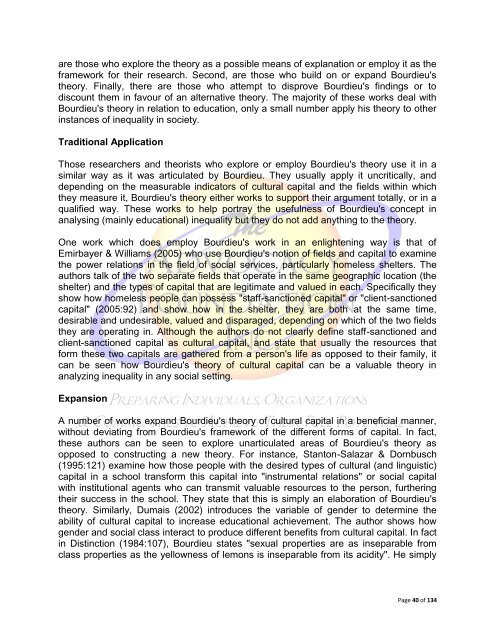Cultural Transformation
Cultural Transformation
Cultural Transformation
You also want an ePaper? Increase the reach of your titles
YUMPU automatically turns print PDFs into web optimized ePapers that Google loves.
are those who explore the theory as a possible means of explanation or employ it as the<br />
framework for their research. Second, are those who build on or expand Bourdieu's<br />
theory. Finally, there are those who attempt to disprove Bourdieu's findings or to<br />
discount them in favour of an alternative theory. The majority of these works deal with<br />
Bourdieu's theory in relation to education, only a small number apply his theory to other<br />
instances of inequality in society.<br />
Traditional Application<br />
Those researchers and theorists who explore or employ Bourdieu's theory use it in a<br />
similar way as it was articulated by Bourdieu. They usually apply it uncritically, and<br />
depending on the measurable indicators of cultural capital and the fields within which<br />
they measure it, Bourdieu's theory either works to support their argument totally, or in a<br />
qualified way. These works to help portray the usefulness of Bourdieu's concept in<br />
analysing (mainly educational) inequality but they do not add anything to the theory.<br />
One work which does employ Bourdieu's work in an enlightening way is that of<br />
Emirbayer & Williams (2005) who use Bourdieu's notion of fields and capital to examine<br />
the power relations in the field of social services, particularly homeless shelters. The<br />
authors talk of the two separate fields that operate in the same geographic location (the<br />
shelter) and the types of capital that are legitimate and valued in each. Specifically they<br />
show how homeless people can possess "staff-sanctioned capital" or "client-sanctioned<br />
capital" (2005:92) and show how in the shelter, they are both at the same time,<br />
desirable and undesirable, valued and disparaged, depending on which of the two fields<br />
they are operating in. Although the authors do not clearly define staff-sanctioned and<br />
client-sanctioned capital as cultural capital, and state that usually the resources that<br />
form these two capitals are gathered from a person's life as opposed to their family, it<br />
can be seen how Bourdieu's theory of cultural capital can be a valuable theory in<br />
analyzing inequality in any social setting.<br />
Expansion<br />
A number of works expand Bourdieu's theory of cultural capital in a beneficial manner,<br />
without deviating from Bourdieu's framework of the different forms of capital. In fact,<br />
these authors can be seen to explore unarticulated areas of Bourdieu's theory as<br />
opposed to constructing a new theory. For instance, Stanton-Salazar & Dornbusch<br />
(1995:121) examine how those people with the desired types of cultural (and linguistic)<br />
capital in a school transform this capital into "instrumental relations" or social capital<br />
with institutional agents who can transmit valuable resources to the person, furthering<br />
their success in the school. They state that this is simply an elaboration of Bourdieu's<br />
theory. Similarly, Dumais (2002) introduces the variable of gender to determine the<br />
ability of cultural capital to increase educational achievement. The author shows how<br />
gender and social class interact to produce different benefits from cultural capital. In fact<br />
in Distinction (1984:107), Bourdieu states "sexual properties are as inseparable from<br />
class properties as the yellowness of lemons is inseparable from its acidity". He simply<br />
Page 40 of 134

















